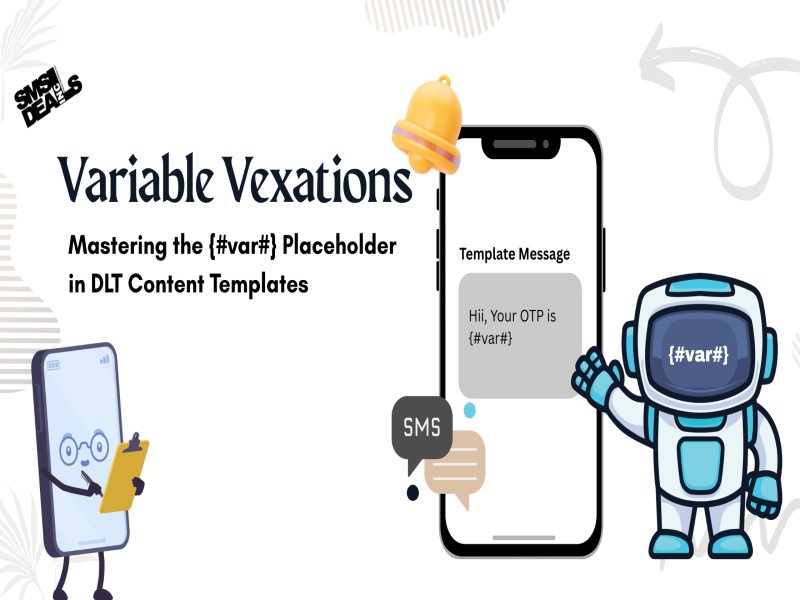
Variable Vexations: Mastering the {#var#} Placeholder in DLT Content Templates
14 Oct-2025 - By Admin 224The shift to Distributed Ledger Technology (DLT) for commercial communication in countries like India has brought a wave of compliance requirements, especially around SMS messaging. A central, and often vexing, component of this compliance is the Content Template, and within it, the crucial placeholder: {#var#}. Mastering this variable is key to ensuring your transactional, service, and promotional SMS messages are delivered consistently and without rejection.
What is a DLT Content Template?
A DLT Content Template is a pre-approved message format that enterprises must register with their respective DLT operators (telecom providers) before sending out SMS communications to customers. This regulatory step aims to curb unsolicited commercial communication (spam) by ensuring that every message sent is tied to a pre-sanctioned structure.
The templates contain two essential parts:
Fixed Content: The static, unchanging part of the message (e.g., "Dear customer," or "Your order is confirmed.").
Variable Content: The dynamic part that changes with each recipient or transaction (e.g., customer name, OTP, amount, order number). This is where the {#var#} placeholder comes in.
The Power and Precision of {#var#}
The {#var#} tag is the designated, case-sensitive placeholder used across all DLT platforms to denote the variable part of your SMS content. It is the only accepted format for dynamic content in DLT-approved templates.
Key Rules for Using {#var#}
Ignoring the precise rules for this variable is the most common reason for template rejection or, worse, message delivery failure.
Handling Long Variables: The Duplication Trick
What if the information you need to insert, like a long tracking URL or a detailed product name, consistently exceeds the 30-character limit? You can employ a clever workaround by using contiguous variables:
Incorrect: "Your tracking link is: {#var#}" (if the link is 55 characters long).
Correct: "Your tracking link is: {#var#}{#var#}" (This combines two 30-character slots for up to 60 characters).
This technique must be registered on the DLT platform exactly as you intend to use it, proving your justification for the extended length.
Best Practices for DLT Template Mastery
To navigate DLT compliance smoothly, adopt these best practices when crafting your templates:
Fixed Content Minimum: Ensure at least 30% of your total template characters are fixed content. The DLT system wants the template's purpose to be immediately clear.
Explicit Context: The fixed part of the message must clearly explain what the variable represents.
Good: "Your OTP is {#var#}."
Bad: "Hey, {#var#} is the code."
No Double Spaces: A seemingly minor detail, but DLT scrubbing rejects templates with two or more consecutive spaces. Use a text editor like Notepad++ to check for and remove invisible double spaces before submission.
Brand Mention is Mandatory: The brand name (or a recognizable abbreviation) must be mentioned in the content of the SMS for all categories (Transactional, Service, Promotional).
Use Variables for All Dynamic Data: Any value that changes—date, amount, OTP, name, link, etc.—must be replaced by a {#var#}. Hardcoding a variable value and changing it later is a violation.
Frequently Asked Questions (FAQs)
Q1: Is the {#var#} placeholder case-sensitive?
A: Yes, the placeholder is case-sensitive. You must use lowercase: {#var#}. Using {#VAR#} or any other casing will lead to rejection.
Q2: What is the maximum character limit for the content replacing one {#var#}?
A: The standard maximum character limit for the dynamic content replacing a single {#var#} placeholder is 30 characters.
Q3: Can I use multiple {#var#} placeholders for a single long variable?
A: Yes. If your variable is expected to exceed 30 characters (e.g., a long URL), you can use contiguous variables like {#var#}{#var#} to effectively double the character limit to 60. This must be justified during template submission.
Q4: Are special characters allowed in the fixed part of the template?
A: Most keyboard special characters are allowed, but generally, the less-than sign (<) and greater-than sign (>) symbols are prohibited as they can be used for injecting code.
Q5: Can a DLT Content Template be just a single {#var#}?
A: No. Templates must contain a minimum amount of fixed content to establish context and prevent misuse. Pure variable content alone is not allowed, except in very rare, specific OTP scenarios. The minimum fixed character count is typically 6.
